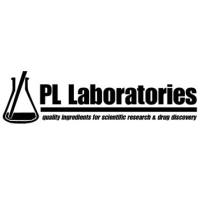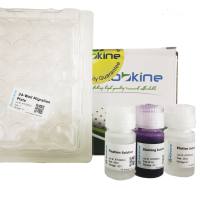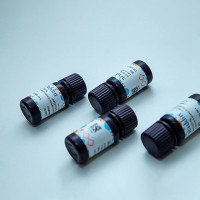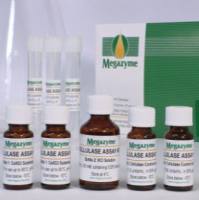碳水化合物分析
互联网
-
Carbohydrate Assay (Hancock Laboratory) (Accessible only by IE)
This protocol is used to determine the relative amounts of LPS CHO present in a given strain. The assay can be done on one set of samples and then scanned at the usr/localious wavelengths for reasonable data on the 3 types of sugars.
§ Sequencing of a Phosphorylated N-Linked Oligosaccharide (Glyko Inc.)
§ Enzymatic Sequencing of Lewis Oligosaccharide Structures using FACE (Glyko Inc.)
§ Enzymatic Removal of N- & O-Linked Oligos from Glycoproteins (Glyko Inc.)
§ A Simple Gel Electrophoretic Method for Analyzing the Muropeptide Composition of Bacterial Peptidoglycan (Glyko Inc.)
§ Identification of Glycosaminoglycan Disaccharides (Glyko Inc.)
§ Quantitation of Heparin in Human Plasma (Glyko Inc.)
§ Sequencing N-Linked Oligosaccharides on rgp120 (Glyko Inc.)
§ Sequencing of a Plant N-Linked Oligosaccharide (Glyko Inc.)
-
Micro-Scale Isolation and Purification of Gangliosides (Glycoteck)
This solvent partition method permits the isolation of gangliosides from small samples and from samples in which the ganglioside concentration is low, especially relative to the concentration of potentially contaminating proteins and other large molecular weight species. The method consists of three steps: (1) preparation of a dry total lipid extract, (2) partition of the total lipid extract in di-isopropyl ether/1-butanol/aqueous NaCl, and (3) Sephadex G-50 gel exclusion chromatography. The final total ganglioside preparation is lyophilized and stored in the dry state. -
Immunohistochemistry using Anti-Ganglioside Antibodies (Glycoteck)
An indirect method using immuno- fluorescence coupled to second antibody is a relatively simple, rapid, and easy immuno-histochemical procedure. It is best suited for the study of membrane antigens in addition to intra- and extracellular antigens, and may be applied to frozen tissue sections, to cells in suspension, and to cells attached to glass slides or coverslips. -
Deglycosylation of Glycoproteins Using Endoglycosidases (Glycoteck)
Parameters of deglycosylation usr/localy with every glycoprotein and must be determined empirically. Human transferrin is an example of a glycoprotein containing two asparagine-linked alfa-fucosyl-biantennary chains, one of which is only released slowly by endoglycosidases even after denaturation in SDS. A typical test reaction on human transferrin is described in This protocol -
Immunostaining Thin Layer Chromatograms Of Glycolipids (Glycoteck)
This protocol allows for the determination of the number, the size (Rf value) and the charge (combined with DEAE chromatography) of the carbohydrate ligand(s). Furthermore, this method aids in determining the method to use for purification of the glycolipid ligand and subsequently to monitor the purification process -
Analysis of Oligosaccharide Ligands by High Performance Liquid Affinity Chromatography (Glycoteck)
This protocol describes an effective and simple method including in situ coating an IgG or an IgG-chimeric protein to a perfusion chromatographic column of protein A followed by an optional cross-linking procedure. -
Dynamic Flow Assay in a Parallel Plate Flow Chamber (Glycotek)
Flow assays allow visualization of cell adhesion under well-defined wall shear stress. The visualization of the different events of cell adhesion can be quantified by selective image acquisition and subsequent image processing. Flow assays are uniquely suited to the investigation of adhesive events which occur very rapidly in a time scale shorter than that of most static adhesion assays. In addition, events subsequent to the initial events can be studied such as cell stabilization and spreading giving some insight into the kenetics of particular cell-cell or cell-substrate adhesive behavior. -
Measurement of Cell Adhesion Under Static Conditions (Glycoteck)
This protocol introduces the use of a liquid-filled wash chamber that separates unbound cells by gravity thereby eliminating uncontrolled shear forces and passage of adherent cells through a liquid/air interface. This protocol is also useful for assaying molecules that promote or inhibit cell adhesion. -
Carbohydrate-Specific Adhesion of Intact Cells to Resolved Glycolipids on TLC Plates (Glycoteck)
his procedure allows detection of specific cell adhesion to glycolipids resolved on TLC plates. The steps include: (1) HPTLC of glycoconjugates, (2) coating the chromatogram with polymer, (3) preblocking the chromatogram to reduce non-specific cell binding, (4) mounting the chromatogram in the acrylic chamber, (5) adding labeled cells, (6) incubating, (7) removal of non-adherent cells by centrifugation, and (8) fixation of adherent cells for detection.









